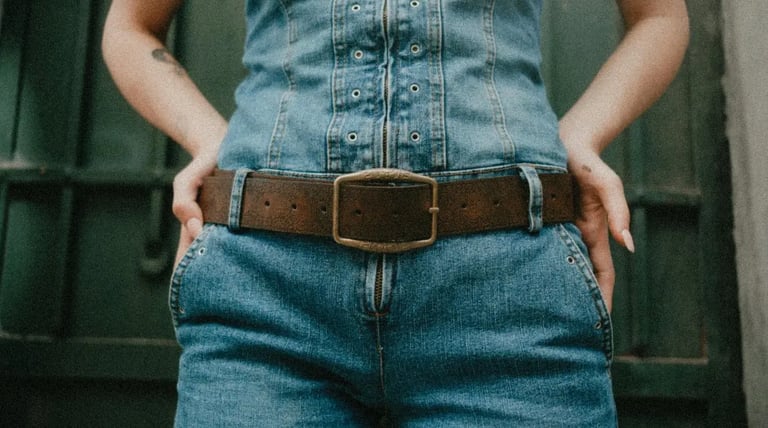From Blue Jeans to Blueprints: How Old Denim is Reinventing Home Insulation
SUSTAINABILITYINNOVATION


In an industrial warehouse on the outskirts of Phoenix, Arizona, a mountain of faded blue jeans waits to be reborn. Some are frayed at the knees, others streaked with years of wear and work — remnants of styles long out of fashion. But here, fashion isn’t the point. These jeans are about to start a second life — not on someone’s legs, but inside the walls of someone’s home.
This is the unlikely new frontier of sustainable construction: turning old denim into high-performance, eco-friendly insulation.
The Denim Dilemma
Denim has always been more than just fabric — it’s cultural armor, worn by miners, rebels, movie stars, and millennials alike. Yet behind its timeless appeal lies a hidden problem. Every year, the world produces over 4.5 billion pairs of jeans, and millions of them end up discarded, often after just a few years of use.
Textile waste is a mounting global crisis. The Ellen MacArthur Foundation estimates that the equivalent of a garbage truck full of textiles is landfilled or burned every second. Denim, made primarily from cotton, is both durable and resource-intensive — one pair of jeans can take up to 7,000 liters of water to produce.
When these garments are thrown away, that embodied energy and water are lost too. But now, thanks to a growing network of recycling innovators, those same jeans are being given a new purpose — one that warms homes instead of clogging landfills.
From Closet to Construction Site
The process begins with collection. Organizations like Blue Jeans Go Green, a program launched by the cotton industry in the U.S., gather unwanted denim through retail partners and donation drives. Instead of reselling the garments, the fabric is shredded into loose fibers.
Those fibers are treated with borate, a natural mineral that makes the material flame-retardant and resistant to mold, pests, and mildew. Then, the fibers are compressed into thick, fluffy batts or rolls — the same form as conventional fiberglass insulation.
The final product, known commercially as UltraTouch Denim Insulation, is soft to the touch, safe to handle without gloves or masks, and surprisingly effective. It’s not uncommon for construction workers to describe it as “working inside a giant blanket.”
The Science of Staying Warm
Insulation works by trapping tiny pockets of air within its fibers, slowing down heat transfer. Cotton — the main component of denim — is naturally adept at this. Laboratory tests show that denim insulation’s R-value, the measure of thermal resistance, is roughly equivalent to that of fiberglass, meaning it performs just as well at keeping heat in during winter and out during summer.
But denim brings a few extra perks. It has superior sound absorption properties, making it a popular choice for music studios, theaters, and homes in noisy urban areas. It’s also entirely free from formaldehyde, volatile organic compounds (VOCs), or tiny glass fibers — all of which can pose health hazards when using synthetic alternatives.
“Fiberglass is efficient, but it comes with environmental and occupational drawbacks,” explains Dr. Lauren Sato, a materials scientist specializing in sustainable building products. “Denim insulation eliminates those concerns while offering comparable performance. It’s a win-win for builders and the planet.”
Building a Circular Future
The denim insulation movement fits neatly into a broader global shift toward a circular economy — an industrial model that designs waste out of the system. Instead of viewing products as disposable, circular systems keep materials in use for as long as possible through recycling, repurposing, or regeneration.
In this case, what was once fast fashion waste becomes a long-lasting building material with a lifespan of 50 years or more. Each pound of recycled denim diverts waste from landfills and reduces the demand for virgin resources. According to Blue Jeans Go Green, the initiative has recycled over 2,500 tons of denim since its launch in 2006 — enough to insulate more than 10,000 homes.
“The beauty of denim insulation is that it tells a story,” says Kelly Nelson, a spokesperson for the program. “When people learn that the walls of their house might contain old jeans, it creates a tangible connection between their lifestyle choices and the planet.”
Challenges and Costs
Despite its promise, denim insulation hasn’t yet gone mainstream. The main hurdle is cost. On average, it can be 10–20% more expensive than fiberglass or mineral wool insulation. For large-scale developers working on tight margins, that difference can be decisive.
There’s also the issue of supply consistency — while denim is abundant, gathering and processing post-consumer fabric at scale is complex. Unlike uniform industrial materials, donated textiles vary widely in fiber quality, color, and composition, which complicates recycling efforts.
However, advocates argue that the long-term benefits far outweigh the initial expense. Denim insulation lasts for decades, doesn’t release harmful particles into the air, and requires less protective equipment during installation — reducing health risks and disposal costs.
“We have to start thinking beyond upfront price tags,” says sustainable architect Miguel Ramirez. “If we factor in environmental impact, worker safety, and indoor air quality, denim becomes a much more economical choice in the long run.”
Denim’s Second Act
As climate change intensifies and consumers demand more sustainable products, the building industry is under increasing pressure to innovate. Governments are introducing incentives for green materials, and homeowners are seeking eco-friendly upgrades. In this context, denim insulation represents more than a niche product — it’s a symbol of transformation, turning yesterday’s trends into tomorrow’s infrastructure.
Beyond insulation, companies are exploring ways to incorporate recycled denim into acoustic panels, furniture padding, and even composite materials for automotive interiors. The potential applications are vast — limited only by imagination and investment.
A Warmer World, One Pair at a Time
Back in the Phoenix warehouse, another batch of denim batts is loaded onto a truck bound for a new housing development. The jeans that once roamed streets, concerts, and workplaces are headed somewhere quieter — between the studs of freshly built walls.
They’ll never be seen again, but their legacy will endure: keeping families warm, reducing energy use, and proving that even in the age of disposable fashion, nothing truly has to go to waste.
As the saying goes, blue never goes out of style — and now, neither does sustainability.


